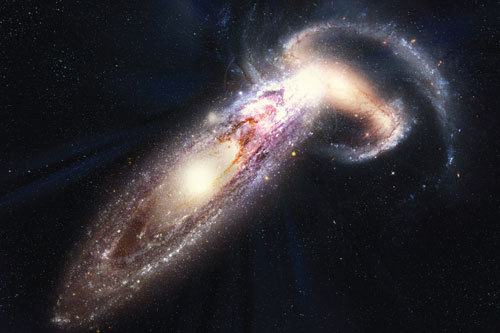In a groundbreaking shift in cosmic forecasting, astronomers have updated the estimated timeline for the collision between the Milky Way and the Andromeda Galaxy—our closest galactic neighbor. While it was previously believed that the two galaxies were on a direct course to collide in about 4 to 5 billion years, new research suggests that the merger might not occur for up to 10 billion years, or may even be avoided entirely in some scenarios.
This updated prediction not only redefines our understanding of galactic evolution but also offers new insights into how gravitational interactions shape the structure of the universe.
🔭 Background: A Celestial Dance Billions of Years in the Making
The Milky Way and Andromeda (also known as M31) are two spiral galaxies within the Local Group, a cluster of more than 50 galaxies. Andromeda is approximately 2.5 million light-years away and has long been on a collision course with the Milky Way due to the gravitational pull between the two massive structures.
Earlier models, largely based on visual and spectroscopic data, predicted a near-certain collision between these galaxies, resulting in the formation of a single elliptical galaxy often dubbed “Milkomeda.” However, recent advances in astrophysical modeling and more precise measurements from observatories like Gaia have led scientists to reassess that timeline and even consider alternate outcomes.
🛰️ New Findings: The Role of the Large Magellanic Cloud
One of the key factors influencing the revised timeline is the gravitational pull of the Large Magellanic Cloud (LMC), a companion galaxy orbiting the Milky Way. Though much smaller than Andromeda or the Milky Way, the LMC has a substantial dark matter halo that is now believed to significantly affect the dynamics of our galaxy.
Recent simulations that factor in the gravitational effect of the LMC indicate it could be shifting the Milky Way’s path and velocity, potentially altering the expected course and timing of its interaction with the Andromeda Galaxy. These updated models indicate a 50% chance that the collision may occur much later than initially projected, or that it might result in a gentle pass-by rather than a catastrophic merger.
📊 What the Numbers Say
Here are some of the revised estimates based on the latest data:
- Initial predictions placed the collision about 4 to 5 billion years in the future.
- Updated collision estimate: Up to 10 billion years, with a wide margin of uncertainty
- Chance of direct collision: Reduced to about 50%
- Chance of near-miss or delayed interaction: Significantly higher than previously thought
These findings stem from a combination of advanced numerical simulations and high-precision astrometric data gathered by ESA’s Gaia spacecraft, which tracks the motion of stars and galaxies with unprecedented accuracy.
🌠 What a Galactic Collision Would Look Like
If the Milky Way and Andromeda eventually do collide, the event would be a slow, majestic dance lasting billions of years. Despite the massive scale of both galaxies, the vast distances between individual stars mean that direct star-on-star collisions would be extremely rare.
Instead, gravitational forces would distort both galaxies, triggering new star formation and possibly reshaping them into a single, elliptical galaxy. The solar system could be propelled into a new area of the galaxy or may experience little change at all.
Importantly, this cosmic event, while monumental on a galactic scale, poses no immediate threat to Earth or human life, given its distant timeline.
🧬 Scientific Relevance and Future Research
This revised outlook on the Milky Way-Andromeda merger has broad implications for the study of galactic evolution. Understanding how massive objects like the LMC influence galaxy dynamics allows astronomers to create more accurate models for the behavior of galaxies across the universe.
Dr. Roeland van der Marel, an astrophysicist involved in the study, stated:
“This research shows that even relatively small galaxies, when containing significant dark matter, can exert powerful gravitational effects on much larger systems.”
Future missions, including James Webb Space Telescope observations and deeper Gaia data releases, are expected to refine our understanding even further.
🌌 Conclusion: A New Perspective on a Timeless Event
While the Milky Way-Andromeda collision has long fascinated both astronomers and the public alike, this updated research provides a new perspective on how uncertain and dynamic cosmic events can be. The possibility that the galaxies may avoid a catastrophic collision — or at least delay it significantly — highlights the complex and evolving nature of our universe.
For now, Earth remains safely nestled within a relatively stable arm of the Milky Way, with billions of years to explore the cosmos before any such galactic encounter occurs.





